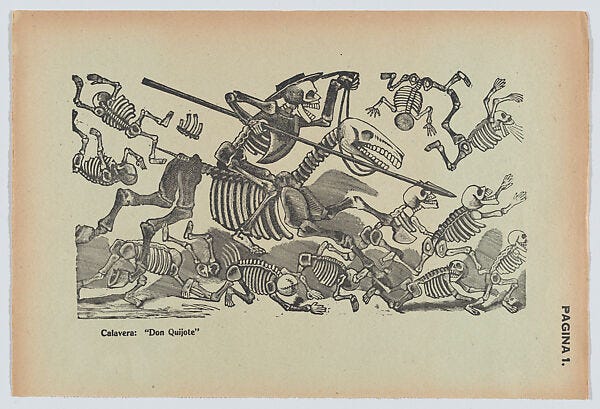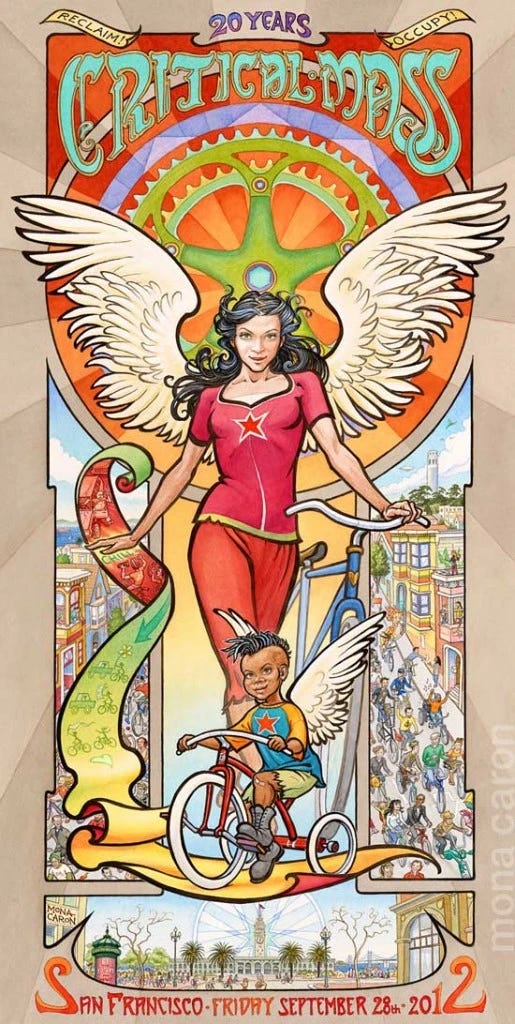A bit of an angry rant today! If that doesn’t fit your mood, skip down to the recommended readings (I got some good ones this week), and I promise I’ll try to send out something gentler next time! Or skip halfway down to the list of asterisks, which is about where the rant ends and the analysis begins!
Today I need to gripe and vent and spew. Really, what I want is to get to a more balanced discussion of how systems are more powerful than the sum of individual behaviors, of how important our context is in shaping us. But really really, I want to complain about how much I hate American drivers.
I often winge about how the US is the only country in the world where you can have a mile long traffic jam on a double lane highway caused by just two drivers, because of how frequently two absolute toolboxes will be driving right next to each other at the exact same speed, completely lacking any self- or situational awareness, oblivious to the fact of the hundreds of cars clogged up behind them. Or maybe it’s only a temporary jam because one driver wants to go exactly ½ a mph faster than the other driver and takes a full two minutes to pass (on the right or the left).
Also, the US is the only country where you’ll have a mile long traffic jam, because in any other country it’s gonna be a 1.6 kilometer long traffic jam, and we’re special like that.
In a normal driving context, I would never dream of passing someone on the right, but in the US, when the left lane is occupied by some asshat cruising along 3mph below the speed limit, contemplating their life, oblivious to the high beams you’re flashing at them, what else are you going to do?
Drivers pass on the right, they weave, they change lanes without signalling, they don’t make room for merge lanes, they don’t turn their headlights on in the rain and snow, they don’t drive stick so they probably think they’re in a fuckin go-cart, and they roar right through crosswalks even if you’re right out in them. In the span of a week, one driver killed a pedestrian blowing through a crosswalk with flashing yellow lights just outside a library, a few blocks from where I sit writing this, and another driver killed another pedestrian by racing through a red light and smashing a car into the crosswalk. Also just a few blocks away. You have to go to a country about as insane as Russia* in order to find willfully homicidal drivers of the caliber of the US of A. Countries without the resources for regulated traffic systems are going to be chaotic places for driving, but people do the best they can in a way that is unimaginable in the States.
*All the love for the Russians; it’s only in response to the insistence of Slavic friends that I’m including this comparison.
There’s also the tendency towards insanely huge trucks and SUVs. Nevermind their mileage, these ego boats are justified as being safer, a result they achieve while increasing overall traffic fatalities. In other words, you’re presented with a choice. Option A, fewer people die but you have no special protection. Option B, more people die, but you’re relatively less likely to be one of them. Only a people that are supremely stupid or supremely narcissistic, or both, would choose B.
Their presumed right to be homicidal even outweighs any thought of self-preservation. When I’m at work and my truck is fully loaded, and the lane I’m in is about to end or it becomes “exit only,” I’ll signal a lane change. A common response from whatever driver happens to be farther back in that lane is to speed up, and then to get mad at me if I take the lane anyway. Even in their three-quarter ton trucks, I would flatten them like a pancake if they collided with me, yet still they seem to prefer that outcome over letting someone execute a duly signalled lane change.
Alas, despite how good a little self-righteous rage feels, I’m not immune. I noticed early on that I get more aggressive driving when I’m back here. I still respect crosswalks, drive pedagogically, and favor the left for passing, but I am not above some aggressive weaving to get somewhere a few seconds sooner. My go-to excuse is that these are my taxi driver instincts coming back up, seventeen years after I left that job. Which is, maybe, not the most solid justification. But it does give me the opportunity to distract you with another, tangential rant! This one’s about the disappearance of taxis.
It just bothers me that I’ve never seen it said anywhere: taking an Über is tantamount to scabbing. Taxi drivers have (had) a certain level of standards and protections that Uber drivers don’t, and in several countries around the world labor organizing and blockades by taxi drivers kept Uber out. It’s a moot point, not sensible grounds for a crusade, once all the taxi companies have been driven out of business, but it’s worth noting how a total lack of class consciousness and a trust in bullshit trendy hipster apps go hand in hand.
So let’s get back to the problem of American driving, and the 40,000 or so people who fall victim to it every year, including over 7,000 pedestrians, with tens of thousands more given lifelong injuries.
According to a rationalist approach in which the chief criterion were safeguarding the greatest common good, I would guess 60% of Americans if evaluated by their driving would have to be put to death as they intentionally pose a lethal danger to those around them. However, intensive testing will show that if you place them in a different context, they are actually sentient beings capable of reflection, self-awareness, and analytical perception of the consequences of actions. They’re even capable of great acts of care, something any reasonable observer would think impossible if they were only seen behind a wheel. Amazingly, Americans are not murderbots! And anyway, we’ve all seen I, Robot, we know that governing society by rationalist criteria for minimizing harm is a recipe for disaster. So I don’t actually think we should execute all those people for being asshole drivers. Most days.
So how do we make sense of this? Let’s get analytical and put it in language befitting a dissertation: an asshole context makes people assholes. A system is greater than the sum of the individual actions that constitute it. The architecture of the highway system conditions those who move through it, training them to act in certain ways, encouraging certain behaviors and resisting others. Modern highways were built to facilitate war mobilizations in the mid-20th century, and they constitute an intervention of social control in other ways. They break the critically strategic unionization of rail workers and the collective, classed experience of train travel in favor of the individualistic, middle class aspirations of car culture. They were also indispensable to white flight and the growth of the middle class suburbs. Cars became a key commodity for national industrial growth in all the competitive economies after World War II. Nor is it meaningless that the triangular logos of a couple companies represent the propellers of the warplanes those companies used to manufacture. Cars constitute a war measure against society (just as the railroads did, a century before that).
But what makes American drivers particularly homicidal? Is it the residual violence of a settler state? I’ve never driven in Australia, I don’t have enough data for comparison, but a highway architecture alone doesn’t explain the problem.
What’s clear is that a materialist analysis of infrastructure and superstructure doesn’t map onto this phenomenon well. What we have instead is an architecture with an overwhelming role in conditioning the behavior of the people who move through it; an institution that designs, implements, and regulates the architecture; and the people captured in the architecture, who only have a chance of changing or destroying the architecture if they develop a collective consciousness of it and build the power necessary to overcome the institution.
Some cogent points:
*the architecture is not produced by the evolution of economic forces. It is produced by an institution that designs a conscious, explicit blueprint, an institution with a scientific understanding of its actions.
*that institution is bound by economic considerations, as it needs considerable material resources to build and regulate the architecture, whether that’s a highway or a public school system. It also needs to be generative of a value that can be extracted for future use in order to reproduce its own relationship to the whole, as the imposition of a blueprint is not a moment, it is an ongoing projection onto a territory and into the future.
*any social architecture is built on top of something that already existed, and it captures and reconditions beings that were used to moving in different orbits. Therefore it will produce resistance, therefore the institution that implements it requires access to a monopoly on decision-making authority and thus access to effective police force.
*thus, the science that guides the institution’s actions is simultaneously a material science and a science of social control.
*though the people designing and implementing the blueprints do so consciously—we are not talking about blueprints as a metaphor but as an actual artifact—they have no way of knowing the extent of how the new architecture will affect society and reality, so they are constantly learning from but also being less-than-consciously shaped by it. They are constantly catching up to the world they have created and bending under the weight of it.
*nonetheless, those with the most power in the institutions are constantly creating a world that is outside of their architecture as much as possible. They are not the captives of public education, public housing, public healthcare. Between helicopters and private limos, artisans on retainer or personal assistants to go shopping, they either bypass or insulate themselves from the highways and shopping malls.
*the people who run the wheels of this architecture, give it purpose and make it work, are captives. They are a troublesome resource, but the fundamental resource, without which the existence of the institution and the architecture are both unthinkable.
*therefore, any architecture in any society, provided that by architecture we understand a logically unified set of structures imposed from a blueprint onto a territory that is assumed inert requires a fundamental feature in order to succeed in the long term: that it inculcate in its captives some sort of falsifying consciousness that prevents them from developing a collective and strategic awareness of their situation.
It is at that point of collective consciousness, and only at that point, that an architecture can be subverted. Cars become getaway vehicles; highways become the sites of blockades. A conflictive distinction emerges here. You have the captives, who keep moving through the architecture as they are intended to; the conscious rebels disrupting it; and the planners from the relevant institution, who may want to restore the architecture’s traditional functioning or they may want to learn from the current malfunction to make it work even better.
None of these groups are on the same side. The captives may not like their lives in the dominant architecture, but it can be easy to blame the rebels for causing their malaise or at least adding to the inconvenience. The rebels need to get more captives on their side, but they can easily look down on them, see them as obstacles, be snitched out or run over by them. And the planners have to dehumanize the captives and neutralize or eliminate the rebels in order to exist as planners, but they need to domesticate the captives and learn from the rebels or they will be overthrown.
A problem for the rebels is that, until yesterday, most of them were captives, meaning their view of life and history was completely conditioned by the architectures they were imprisoned in. Most of them will not know that society without blueprints (and the institutions that draft them) is possible. They will get confused and think that their purpose is to improve the architecture, whether by communicating with or replacing the dominant institution. Others will develop a consciousness of their collectivity that is sorely limited. They are no longer atoms, no longer individualized citizens of the architecture. Now they are a we, now they are rebels, but they might assume that all the rebels or all the captives are the same. They will not remember that the architecture of power rests on white supremacy, on class society, on patriarchy, on rationalism and Christianity, on ableism, that it came in a thousand different ways to the thousand different corners of the world and that these differences matter intimately and intensely.
They will forget that when the barbarians sacked Rome, they tried to resurrect it.
More often than not, rebels are absorbed by the more intelligent institutions, or captured by a new architecture. I can think of the recent examples of internet news and social media. How Indymedia were pioneers of online reporting. How a text message service made by anarchists to spread news about where the police were during a street protest was the precursor to Twitter.
I fell hard into the asshole context of Twitter. For the first two decades of social media I abstained, both horrified and uninterested. But as the architecture spread, the terrain in which I had been trying to spread radical ideas as a writer was disappearing. Finally I signed up, right before the pandemic hit. My first year (or two?) on Twitter, I was there with the worst of them, letting disagreements turn into nasty fights. I do believe that there are certain people, especially those in power, who are undeserving of respect, but in general solidaristic and respectful communication with other captives and rebels is a matter of principle for me. Nonetheless, when I clicked open the app, within a few seconds I was like an F-250 passing on the right.
Thank goodness for friends! Thank goodness for the possibility of developing a situational awareness, a consciousness of the architectures that turn us against ourselves. I dream of a world without highways and without social media. But in the meantime, I know there are corners of the internet in which people are supportive rather than mean. I know there are places with highway systems in which people drive like they don’t actually want to kill you. It’s not too late for us. Our actions matter. Rarely as individuals, but with our friends, with larger groups that are moving towards being living, breathing communities, we can reach out a complicit hand to as many captives as possible and enact a way of being that is both care and sabotage, an embrace and a blockade.
Maybe that’s what we need. Rage that orients towards love. Strategies that invite growth, inward and outward and uncontrollable, rather than the perfection of a new architecture.
Postscript: Citations and Tangents
On the power of architectures of control, Alex Gorrion, “Golem in the Catacombs”
Plus the history of a particular urban architecture deployed to meet the needs of capital accumulation and social control in a place called Los Angeles: Mike Davis, City of Quartz
Texts of the Week
Peepshow Podcast interviews Lola Davina on Self-Care in an Anti-Sex Work Era
Raechel Anne Jolie, “an informal annotated bibliography of books regarding sex and culture”
Because in the last newsletter I was talking about ancestry from a decidedly white perspective, I want to open up some room for very different experiences of ancestry. Here are some really important books:
One of the books to break open this topic, Alex Haley’s Roots: The Saga of an American Family
Saidiya Hartman, Lose Your Mother: A Journey Along the Atlantic Slave Route
I haven’t yet gotten to read Patty Krawec’s Becoming Kin: An Indigenous Call to Unforgetting the Past and Reimagining Our Future but it looks promising. Please let me know if you have thoughts on it.
Images by José Guadalupe Posada and Mona Caron. I couldn’t find who made the first image in the newsletter, let me know in the comments if you have any ideas.








You should come drive in the Philippines! I often needed a stiff drink and a lie down after any journey by car